Antibody data
- Antibody Data
- Antigen structure
- References [38]
- Comments [0]
- Validations
- Immunohistochemistry [1]
- Other assay [15]
Submit
Validation data
Reference
Comment
Report error
- Product number
- 71-0600 - Provider product page

- Provider
- Invitrogen Antibodies
- Product name
- Connexin 32 Polyclonal Antibody
- Antibody type
- Polyclonal
- Antigen
- Synthetic peptide
- Description
- 71-0600 was used in the immunofluorescence (IHC) and western blot analysis to successfully detect Connexin 32 in mouse liver.
- Reactivity
- Human, Mouse, Rat
- Host
- Rabbit
- Isotype
- IgG
- Vial size
- 50 μg
- Concentration
- 0.25 mg/mL
- Storage
- -20°C
Submitted references Subcellular Localization of Connexin 26 in Cardiomyocytes and in Cardiomyocyte-Derived Extracellular Vesicles.
Exercise rapidly alters proteomes in mice following spinal cord demyelination.
Connexin 26 Expression in Mammalian Cardiomyocytes.
Endometrial Stromal Decidualization Responds Reversibly to Hormone Stimulation and Withdrawal.
CO2-evoked release of PGE2 modulates sighs and inspiration as demonstrated in brainstem organotypic culture.
Astrocyte sigma-1 receptors modulate connexin 43 expression leading to the induction of below-level mechanical allodynia in spinal cord injured mice.
Increased Cx32 expression in spinal cord TrkB oligodendrocytes following peripheral axon injury.
Segregated Foxc2, NFATc1 and Connexin expression at normal developing venous valves, and Connexin-specific differences in the valve phenotypes of Cx37, Cx43, and Cx47 knockout mice.
Let-7b and miR-495 stimulate differentiation and prevent metaplasia of pancreatic acinar cells by repressing HNF6.
Absence of venous valves in mice lacking Connexin37.
The development and characterization of a human mesothelioma in vitro 3D model to investigate immunotoxin therapy.
Conformational maturation and post-ER multisubunit assembly of gap junction proteins.
Tissue-specific cross-reactivity of connexin32 antibodies: problems and solutions unique to the central nervous system.
Identification of connexin36 in gap junctions between neurons in rodent locus coeruleus.
Intestinal adenomas of Min-mice lack enterochromaffin cells, and have increased lysozyme production in non-Paneth cells.
N-terminal residues in Cx43 and Cx40 determine physiological properties of gap junction channels, but do not influence heteromeric assembly with each other or with Cx26.
Expression of connexins in chromaffin cells of normal human adrenals and in benign and malignant pheochromocytomas.
Connexin-47 and connexin-32 in gap junctions of oligodendrocyte somata, myelin sheaths, paranodal loops and Schmidt-Lanterman incisures: implications for ionic homeostasis and potassium siphoning.
Connexin-specific cell-to-cell transfer of short interfering RNA by gap junctions.
Epithelial-mesenchymal transition in colonies of rhesus monkey embryonic stem cells: a model for processes involved in gastrulation.
Connexin47, connexin29 and connexin32 co-expression in oligodendrocytes and Cx47 association with zonula occludens-1 (ZO-1) in mouse brain.
Truncated mouse adenomatous polyposis coli reduces connexin32 content and increases matrilysin secretion from Paneth cells.
Connexin29 and connexin32 at oligodendrocyte and astrocyte gap junctions and in myelin of the mouse central nervous system.
ECM-induced gap junctional communication enhances mammary epithelial cell differentiation.
Connexin immunoreactivity in glial cells of the rat retina.
Coupling of astrocyte connexins Cx26, Cx30, Cx43 to oligodendrocyte Cx29, Cx32, Cx47: Implications from normal and connexin32 knockout mice.
Role of gap junctions in fluid secretion of lacrimal glands.
Impaired trafficking of connexins in androgen-independent human prostate cancer cell lines and its mitigation by alpha-catenin.
Cell-specific expression of connexins and evidence of restricted gap junctional coupling between glial cells and between neurons.
Cell-specific expression of connexins and evidence of restricted gap junctional coupling between glial cells and between neurons.
Localization of connexin26 and connexin32 in putative CO(2)-chemosensitive brainstem regions in rat.
Localization of connexin26 and connexin32 in putative CO(2)-chemosensitive brainstem regions in rat.
The coiled-coil domain of occludin can act to organize structural and functional elements of the epithelial tight junction.
Intracellular transport, assembly, and degradation of wild-type and disease-linked mutant gap junction proteins.
Intracellular transport, assembly, and degradation of wild-type and disease-linked mutant gap junction proteins.
Immunogold evidence that neuronal gap junctions in adult rat brain and spinal cord contain connexin-36 but not connexin-32 or connexin-43.
Immunogold evidence that neuronal gap junctions in adult rat brain and spinal cord contain connexin-36 but not connexin-32 or connexin-43.
Connexin 26 expression and extensive gap junctional coupling in cultures of GT1-7 cells secreting gonadotropin-releasing hormone.
Falleni A, Moscato S, Sabbatini ARM, Bernardeschi M, Bianchi F, Cecchettini A, Mattii L
Molecules (Basel, Switzerland) 2021 Nov 6;26(21)
Molecules (Basel, Switzerland) 2021 Nov 6;26(21)
Exercise rapidly alters proteomes in mice following spinal cord demyelination.
Lozinski BM, de Almeida LGN, Silva C, Dong Y, Brown D, Chopra S, Yong VW, Dufour A
Scientific reports 2021 Mar 31;11(1):7239
Scientific reports 2021 Mar 31;11(1):7239
Connexin 26 Expression in Mammalian Cardiomyocytes.
Moscato S, Cabiati M, Bianchi F, Vaglini F, Morales MA, Burchielli S, Botta L, Sabbatini ARM, Falleni A, Del Ry S, Mattii L
Scientific reports 2018 Sep 18;8(1):13975
Scientific reports 2018 Sep 18;8(1):13975
Endometrial Stromal Decidualization Responds Reversibly to Hormone Stimulation and Withdrawal.
Yu J, Berga SL, Johnston-MacAnanny EB, Sidell N, Bagchi IC, Bagchi MK, Taylor RN
Endocrinology 2016 Jun;157(6):2432-46
Endocrinology 2016 Jun;157(6):2432-46
CO2-evoked release of PGE2 modulates sighs and inspiration as demonstrated in brainstem organotypic culture.
Forsberg D, Horn Z, Tserga E, Smedler E, Silberberg G, Shvarev Y, Kaila K, Uhlén P, Herlenius E
eLife 2016 Jul 5;5
eLife 2016 Jul 5;5
Astrocyte sigma-1 receptors modulate connexin 43 expression leading to the induction of below-level mechanical allodynia in spinal cord injured mice.
Choi SR, Roh DH, Yoon SY, Kwon SG, Choi HS, Han HJ, Beitz AJ, Lee JH
Neuropharmacology 2016 Dec;111:34-46
Neuropharmacology 2016 Dec;111:34-46
Increased Cx32 expression in spinal cord TrkB oligodendrocytes following peripheral axon injury.
Coulibaly AP, Isaacson LG
Neuroscience letters 2016 Aug 3;627:115-20
Neuroscience letters 2016 Aug 3;627:115-20
Segregated Foxc2, NFATc1 and Connexin expression at normal developing venous valves, and Connexin-specific differences in the valve phenotypes of Cx37, Cx43, and Cx47 knockout mice.
Munger SJ, Geng X, Srinivasan RS, Witte MH, Paul DL, Simon AM
Developmental biology 2016 Apr 15;412(2):173-90
Developmental biology 2016 Apr 15;412(2):173-90
Let-7b and miR-495 stimulate differentiation and prevent metaplasia of pancreatic acinar cells by repressing HNF6.
Prévot PP, Augereau C, Simion A, Van den Steen G, Dauguet N, Lemaigre FP, Jacquemin P
Gastroenterology 2013 Sep;145(3):668-78.e3
Gastroenterology 2013 Sep;145(3):668-78.e3
Absence of venous valves in mice lacking Connexin37.
Munger SJ, Kanady JD, Simon AM
Developmental biology 2013 Jan 15;373(2):338-48
Developmental biology 2013 Jan 15;373(2):338-48
The development and characterization of a human mesothelioma in vitro 3D model to investigate immunotoxin therapy.
Xiang X, Phung Y, Feng M, Nagashima K, Zhang J, Broaddus VC, Hassan R, Fitzgerald D, Ho M
PloS one 2011 Jan 31;6(1):e14640
PloS one 2011 Jan 31;6(1):e14640
Conformational maturation and post-ER multisubunit assembly of gap junction proteins.
Vanslyke JK, Naus CC, Musil LS
Molecular biology of the cell 2009 May;20(9):2451-63
Molecular biology of the cell 2009 May;20(9):2451-63
Tissue-specific cross-reactivity of connexin32 antibodies: problems and solutions unique to the central nervous system.
Fowler SL, McLean AC, Bennett SA
Cell communication & adhesion 2009 Dec;16(5-6):117-30
Cell communication & adhesion 2009 Dec;16(5-6):117-30
Identification of connexin36 in gap junctions between neurons in rodent locus coeruleus.
Rash JE, Olson CO, Davidson KG, Yasumura T, Kamasawa N, Nagy JI
Neuroscience 2007 Jul 29;147(4):938-56
Neuroscience 2007 Jul 29;147(4):938-56
Intestinal adenomas of Min-mice lack enterochromaffin cells, and have increased lysozyme production in non-Paneth cells.
Husøy T, Knutsen HK, Løberg EM, Alexander J
Anticancer research 2006 May-Jun;26(3A):1797-802
Anticancer research 2006 May-Jun;26(3A):1797-802
N-terminal residues in Cx43 and Cx40 determine physiological properties of gap junction channels, but do not influence heteromeric assembly with each other or with Cx26.
Gemel J, Lin X, Veenstra RD, Beyer EC
Journal of cell science 2006 Jun 1;119(Pt 11):2258-68
Journal of cell science 2006 Jun 1;119(Pt 11):2258-68
Expression of connexins in chromaffin cells of normal human adrenals and in benign and malignant pheochromocytomas.
Willenberg HS, Schott M, Saeger W, Tries A, Scherbaum WA, Bornstein SR
Annals of the New York Academy of Sciences 2006 Aug;1073:578-83
Annals of the New York Academy of Sciences 2006 Aug;1073:578-83
Connexin-47 and connexin-32 in gap junctions of oligodendrocyte somata, myelin sheaths, paranodal loops and Schmidt-Lanterman incisures: implications for ionic homeostasis and potassium siphoning.
Kamasawa N, Sik A, Morita M, Yasumura T, Davidson KG, Nagy JI, Rash JE
Neuroscience 2005;136(1):65-86
Neuroscience 2005;136(1):65-86
Connexin-specific cell-to-cell transfer of short interfering RNA by gap junctions.
Valiunas V, Polosina YY, Miller H, Potapova IA, Valiuniene L, Doronin S, Mathias RT, Robinson RB, Rosen MR, Cohen IS, Brink PR
The Journal of physiology 2005 Oct 15;568(Pt 2):459-68
The Journal of physiology 2005 Oct 15;568(Pt 2):459-68
Epithelial-mesenchymal transition in colonies of rhesus monkey embryonic stem cells: a model for processes involved in gastrulation.
Behr R, Heneweer C, Viebahn C, Denker HW, Thie M
Stem cells (Dayton, Ohio) 2005 Jun-Jul;23(6):805-16
Stem cells (Dayton, Ohio) 2005 Jun-Jul;23(6):805-16
Connexin47, connexin29 and connexin32 co-expression in oligodendrocytes and Cx47 association with zonula occludens-1 (ZO-1) in mouse brain.
Li X, Ionescu AV, Lynn BD, Lu S, Kamasawa N, Morita M, Davidson KG, Yasumura T, Rash JE, Nagy JI
Neuroscience 2004;126(3):611-30
Neuroscience 2004;126(3):611-30
Truncated mouse adenomatous polyposis coli reduces connexin32 content and increases matrilysin secretion from Paneth cells.
Husøy T, Ølstørn HB, Knutsen HK, Løberg EM, Cruciani V, Mikalsen SO, Goverud IL, Alexander J
European journal of cancer (Oxford, England : 1990) 2004 Jul;40(10):1599-603
European journal of cancer (Oxford, England : 1990) 2004 Jul;40(10):1599-603
Connexin29 and connexin32 at oligodendrocyte and astrocyte gap junctions and in myelin of the mouse central nervous system.
Nagy JI, Ionescu AV, Lynn BD, Rash JE
The Journal of comparative neurology 2003 Sep 22;464(3):356-70
The Journal of comparative neurology 2003 Sep 22;464(3):356-70
ECM-induced gap junctional communication enhances mammary epithelial cell differentiation.
El-Sabban ME, Sfeir AJ, Daher MH, Kalaany NY, Bassam RA, Talhouk RS
Journal of cell science 2003 Sep 1;116(Pt 17):3531-41
Journal of cell science 2003 Sep 1;116(Pt 17):3531-41
Connexin immunoreactivity in glial cells of the rat retina.
Zahs KR, Kofuji P, Meier C, Dermietzel R
The Journal of comparative neurology 2003 Jan 20;455(4):531-46
The Journal of comparative neurology 2003 Jan 20;455(4):531-46
Coupling of astrocyte connexins Cx26, Cx30, Cx43 to oligodendrocyte Cx29, Cx32, Cx47: Implications from normal and connexin32 knockout mice.
Nagy JI, Ionescu AV, Lynn BD, Rash JE
Glia 2003 Dec;44(3):205-18
Glia 2003 Dec;44(3):205-18
Role of gap junctions in fluid secretion of lacrimal glands.
Walcott B, Moore LC, Birzgalis A, Claros N, Valiunas V, Ott T, Willecke K, Brink PR
American journal of physiology. Cell physiology 2002 Mar;282(3):C501-7
American journal of physiology. Cell physiology 2002 Mar;282(3):C501-7
Impaired trafficking of connexins in androgen-independent human prostate cancer cell lines and its mitigation by alpha-catenin.
Govindarajan R, Zhao S, Song XH, Guo RJ, Wheelock M, Johnson KR, Mehta PP
The Journal of biological chemistry 2002 Dec 20;277(51):50087-97
The Journal of biological chemistry 2002 Dec 20;277(51):50087-97
Cell-specific expression of connexins and evidence of restricted gap junctional coupling between glial cells and between neurons.
Rash JE, Yasumura T, Dudek FE, Nagy JI
The Journal of neuroscience : the official journal of the Society for Neuroscience 2001 Mar 15;21(6):1983-2000
The Journal of neuroscience : the official journal of the Society for Neuroscience 2001 Mar 15;21(6):1983-2000
Cell-specific expression of connexins and evidence of restricted gap junctional coupling between glial cells and between neurons.
Rash JE, Yasumura T, Dudek FE, Nagy JI
The Journal of neuroscience : the official journal of the Society for Neuroscience 2001 Mar 15;21(6):1983-2000
The Journal of neuroscience : the official journal of the Society for Neuroscience 2001 Mar 15;21(6):1983-2000
Localization of connexin26 and connexin32 in putative CO(2)-chemosensitive brainstem regions in rat.
Solomon IC, Halat TJ, El-Maghrabi MR, O'Neal MH 3rd
Respiration physiology 2001 Dec;129(1-2):101-21
Respiration physiology 2001 Dec;129(1-2):101-21
Localization of connexin26 and connexin32 in putative CO(2)-chemosensitive brainstem regions in rat.
Solomon IC, Halat TJ, El-Maghrabi MR, O'Neal MH 3rd
Respiration physiology 2001 Dec;129(1-2):101-21
Respiration physiology 2001 Dec;129(1-2):101-21
The coiled-coil domain of occludin can act to organize structural and functional elements of the epithelial tight junction.
Nusrat A, Chen JA, Foley CS, Liang TW, Tom J, Cromwell M, Quan C, Mrsny RJ
The Journal of biological chemistry 2000 Sep 22;275(38):29816-22
The Journal of biological chemistry 2000 Sep 22;275(38):29816-22
Intracellular transport, assembly, and degradation of wild-type and disease-linked mutant gap junction proteins.
VanSlyke JK, Deschenes SM, Musil LS
Molecular biology of the cell 2000 Jun;11(6):1933-46
Molecular biology of the cell 2000 Jun;11(6):1933-46
Intracellular transport, assembly, and degradation of wild-type and disease-linked mutant gap junction proteins.
VanSlyke JK, Deschenes SM, Musil LS
Molecular biology of the cell 2000 Jun;11(6):1933-46
Molecular biology of the cell 2000 Jun;11(6):1933-46
Immunogold evidence that neuronal gap junctions in adult rat brain and spinal cord contain connexin-36 but not connexin-32 or connexin-43.
Rash JE, Staines WA, Yasumura T, Patel D, Furman CS, Stelmack GL, Nagy JI
Proceedings of the National Academy of Sciences of the United States of America 2000 Jun 20;97(13):7573-8
Proceedings of the National Academy of Sciences of the United States of America 2000 Jun 20;97(13):7573-8
Immunogold evidence that neuronal gap junctions in adult rat brain and spinal cord contain connexin-36 but not connexin-32 or connexin-43.
Rash JE, Staines WA, Yasumura T, Patel D, Furman CS, Stelmack GL, Nagy JI
Proceedings of the National Academy of Sciences of the United States of America 2000 Jun 20;97(13):7573-8
Proceedings of the National Academy of Sciences of the United States of America 2000 Jun 20;97(13):7573-8
Connexin 26 expression and extensive gap junctional coupling in cultures of GT1-7 cells secreting gonadotropin-releasing hormone.
Hu L, Olson AJ, Weiner RI, Goldsmith PC
Neuroendocrinology 1999 Oct;70(4):221-7
Neuroendocrinology 1999 Oct;70(4):221-7
No comments: Submit comment
Supportive validation
- Submitted by
- Invitrogen Antibodies (provider)
- Main image
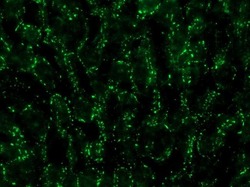
- Experimental details
- Immunofluorescence analysis of connexin 32 was performed on sections of adult mouse liver. Tissue sections on slides were probed for 24 h at 4°C in a humidified chamber with rabbit polyclonal anti-Cx32 (Product # 71-0600), at an antibody concentration of 1-2 µg/mL diluted in 50 mM Tris-HCl, pH 7.4, containing 1.5% NaCl, 0.3% Triton X-100 (TBST) and 4% normal goat serum. After overnight incubation, sections were washed extensively for 1 h in TBST, and detection of primary antibody was performed for 1.5 h at room temperature with AlexaFluor-488-conjugated donkey anti-rabbit diluted 1:600 in TBST. Sections were then was in TBST, then in TBS (without triton) and then coversliped with anti-fade medium. Images were taken on a Zeiss Z2 scanning microscope at x40 objective magnification, and show immunofluorescence labelling of Cx32 localized at gap junctions between liver hepatocytes. Data courtesy of Dr. James Nagy's lab.
Supportive validation
- Submitted by
- Invitrogen Antibodies (provider)
- Main image
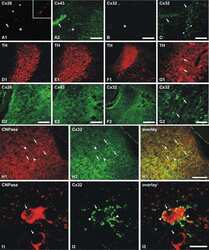
- Experimental details
- NULL
- Submitted by
- Invitrogen Antibodies (provider)
- Main image
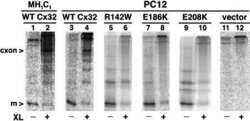
- Experimental details
- NULL
- Submitted by
- Invitrogen Antibodies (provider)
- Main image
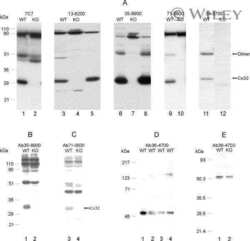
- Experimental details
- NULL
- Submitted by
- Invitrogen Antibodies (provider)
- Main image

- Experimental details
- NULL
- Submitted by
- Invitrogen Antibodies (provider)
- Main image
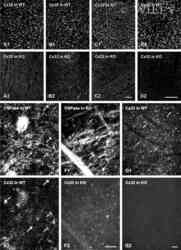
- Experimental details
- NULL
- Submitted by
- Invitrogen Antibodies (provider)
- Main image
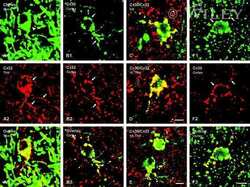
- Experimental details
- NULL
- Submitted by
- Invitrogen Antibodies (provider)
- Main image
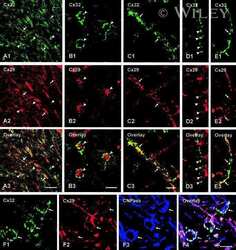
- Experimental details
- NULL
- Submitted by
- Invitrogen Antibodies (provider)
- Main image
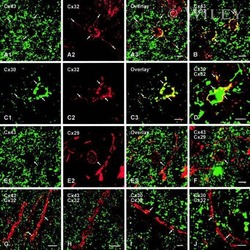
- Experimental details
- NULL
- Submitted by
- Invitrogen Antibodies (provider)
- Main image
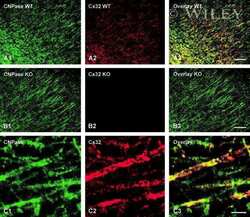
- Experimental details
- NULL
- Submitted by
- Invitrogen Antibodies (provider)
- Main image
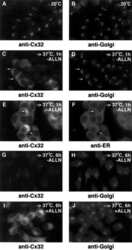
- Experimental details
- NULL
- Submitted by
- Invitrogen Antibodies (provider)
- Main image
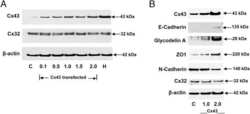
- Experimental details
- NULL
- Submitted by
- Invitrogen Antibodies (provider)
- Main image
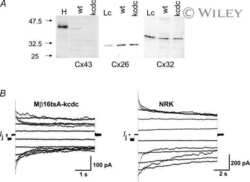
- Experimental details
- NULL
- Submitted by
- Invitrogen Antibodies (provider)
- Main image
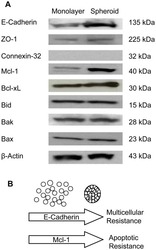
- Experimental details
- Figure 6 Expression of cell junction and Bcl-2 signaling proteins in NCI-H226 monolayers and spheroids. A . Protein expression of E-Cadherin, ZO-1, Connexin-32, Mcl-1, Bcl-xL, Bid, Bak, Bax, and beta-actin examined by Western blot. B . Molecular mechanisms underlying drug resistance in tumor spheroids.
- Submitted by
- Invitrogen Antibodies (provider)
- Main image
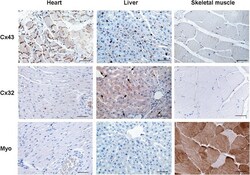
- Experimental details
- Figure 6 Validation of immunoperoxidase analysis on rat tissues. Representative images of immunohistochemical analysis on rat heart, liver and skeletal muscle sections by anti-Cx43, anti-Cx32 and anti-Myo antibodies. Arrow marks pointed positivity of the membrane. Scale bars: 50 um.
- Submitted by
- Invitrogen Antibodies (provider)
- Main image
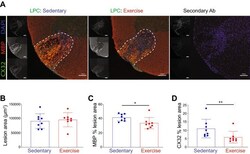
- Experimental details
- Figure 7 Immunofluorescence microscopy of LPC mice validation of shotgun proteomics analysis. ( A ) Representative images of LPC mice from the sedentary control, exercising animals, and secondary control for connexin-32 (CX32), and myelin (MBP). Scale bar denotes 100 mum. ( B ) Quantification of lesion area. ( C ) Quantification of percent of lesion that is MBP-positive. * p < 0.05 . ( D ) Quantification of percent of lesion that is CX32-positive. ** p < 0.01. A Mann-Whitney test was used for statistics. Each point is of a single animal, and the bar represents mean +- SD (n of 8 per group).
 Explore
Explore Validate
Validate Learn
Learn Western blot
Western blot ELISA
ELISA Immunohistochemistry
Immunohistochemistry